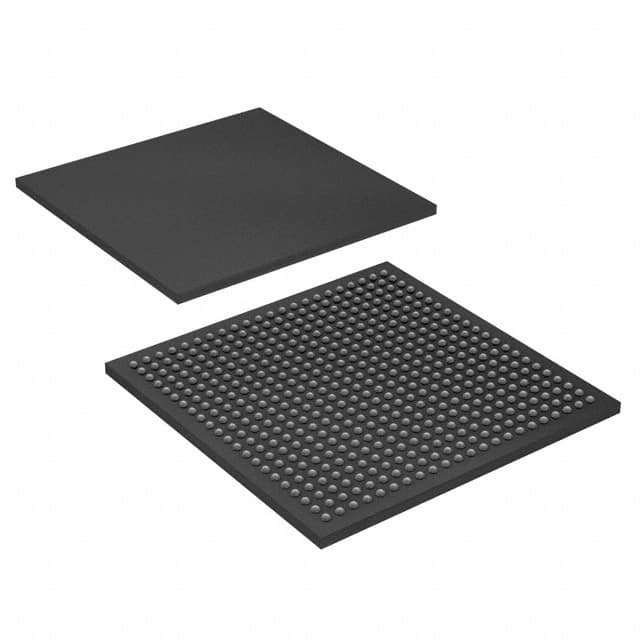EP4CGX30CF23I7
Product Overview
- Category: Programmable Logic Device (PLD)
- Use: EP4CGX30CF23I7 is a PLD used for digital logic design and implementation.
- Characteristics: It offers high-performance, low-power consumption, and flexibility in designing complex digital circuits.
- Package: The EP4CGX30CF23I7 comes in a compact and durable package suitable for various applications.
- Essence: This PLD provides a versatile platform for implementing custom digital logic designs.
- Packaging/Quantity: The EP4CGX30CF23I7 is available in standard packaging with a quantity of one per package.
Specifications
- Logic Elements: 29,440
- Embedded Memory: 414 Kbits
- Maximum User I/O Pins: 179
- Operating Voltage: 1.2V
- Speed Grade: -7
- Package Type: FBGA
- Package Pins: 484
Detailed Pin Configuration
The EP4CGX30CF23I7 has a total of 484 pins, including input/output pins, power supply pins, and configuration pins. The pin configuration is as follows:
- Pin 1: VCCIO
- Pin 2: GND
- Pin 3: IO_0A
- Pin 4: IO_0B
- ...
- Pin 483: IO_178A
- Pin 484: IO_178B
Functional Features
- High-performance: The EP4CGX30CF23I7 offers fast processing speeds, making it suitable for demanding applications.
- Low-power consumption: It is designed to minimize power consumption, ensuring energy efficiency.
- Flexibility: The PLD allows for the implementation of various digital logic designs, providing flexibility in system development.
- Reconfigurability: The EP4CGX30CF23I7 can be reprogrammed multiple times, allowing for design modifications and updates.
Advantages and Disadvantages
Advantages: - High-performance capabilities - Low-power consumption - Flexibility in design implementation - Reconfigurability for design modifications
Disadvantages: - Limited number of I/O pins compared to some other PLDs - Higher cost compared to simpler programmable logic devices
Working Principles
The EP4CGX30CF23I7 operates based on the principles of field-programmable gate arrays (FPGAs). It consists of configurable logic blocks (CLBs), interconnects, embedded memory, and I/O elements. The CLBs can be programmed to implement various digital logic functions, while the interconnects provide connectivity between different components. The embedded memory allows for storage of data within the device. The I/O elements enable communication with external devices.
Detailed Application Field Plans
The EP4CGX30CF23I7 is widely used in various application fields, including:
- Telecommunications: It can be utilized in network routers, switches, and communication equipment.
- Industrial Automation: The PLD is suitable for implementing control systems in industrial automation processes.
- Automotive Electronics: It can be employed in automotive applications such as engine control units and advanced driver-assistance systems (ADAS).
- Consumer Electronics: The EP4CGX30CF23I7 finds applications in smart TVs, gaming consoles, and multimedia devices.
- Medical Devices: It can be used in medical imaging systems, patient monitoring devices, and laboratory equipment.
Alternative Models
- EP4CE6E22C8N
- EP4CE10E22C8N
- EP4CE15E22C8N
- EP4CE20E22C8N
- EP4CE30E22C8N
These alternative models offer similar functionality and performance to the EP4CGX30CF23I7, but with varying logic elements and I/O pin counts.
In conclusion, the EP4CGX30CF23I7 is a high-performance programmable logic device that provides flexibility and low-power consumption for digital logic design. Its wide range of applications makes it a versatile choice in various industries.
Lista 10 Vanliga frågor och svar relaterade till tillämpningen av EP4CGX30CF23I7 i tekniska lösningar
Sure! Here are 10 common questions and answers related to the application of EP4CGX30CF23I7 in technical solutions:
Q: What is EP4CGX30CF23I7? A: EP4CGX30CF23I7 is a specific model of Field-Programmable Gate Array (FPGA) manufactured by Intel.
Q: What are the key features of EP4CGX30CF23I7? A: EP4CGX30CF23I7 offers 30,000 logic elements, 1,080 Kbits of embedded memory, and supports various I/O standards.
Q: What are some typical applications of EP4CGX30CF23I7? A: EP4CGX30CF23I7 can be used in a wide range of applications such as industrial automation, telecommunications, automotive systems, and medical devices.
Q: How does EP4CGX30CF23I7 differ from other FPGA models? A: EP4CGX30CF23I7 has its own unique combination of logic elements, memory capacity, and I/O standards, which makes it suitable for specific use cases.
Q: Can EP4CGX30CF23I7 be programmed after deployment? A: Yes, EP4CGX30CF23I7 is a field-programmable device, meaning it can be reprogrammed even after it has been deployed in a system.
Q: What programming languages can be used with EP4CGX30CF23I7? A: EP4CGX30CF23I7 can be programmed using Hardware Description Languages (HDLs) such as VHDL or Verilog.
Q: Are there any development tools available for EP4CGX30CF23I7? A: Yes, Intel provides development tools like Quartus Prime software suite that supports EP4CGX30CF23I7 for design, simulation, and programming.
Q: Can EP4CGX30CF23I7 interface with other components in a system? A: Yes, EP4CGX30CF23I7 has various I/O standards and interfaces like GPIO, UART, SPI, I2C, and PCIe, allowing it to communicate with other components.
Q: What are the power requirements for EP4CGX30CF23I7? A: EP4CGX30CF23I7 typically operates at a voltage range of 1.2V to 3.3V, depending on the specific application and system requirements.
Q: Where can I find more information about EP4CGX30CF23I7? A: You can refer to the official documentation provided by Intel, including datasheets, user guides, and application notes, for detailed information about EP4CGX30CF23I7.
Please note that the answers provided here are general and may vary based on specific requirements and use cases. It is always recommended to consult the official documentation and technical resources for accurate and up-to-date information.


